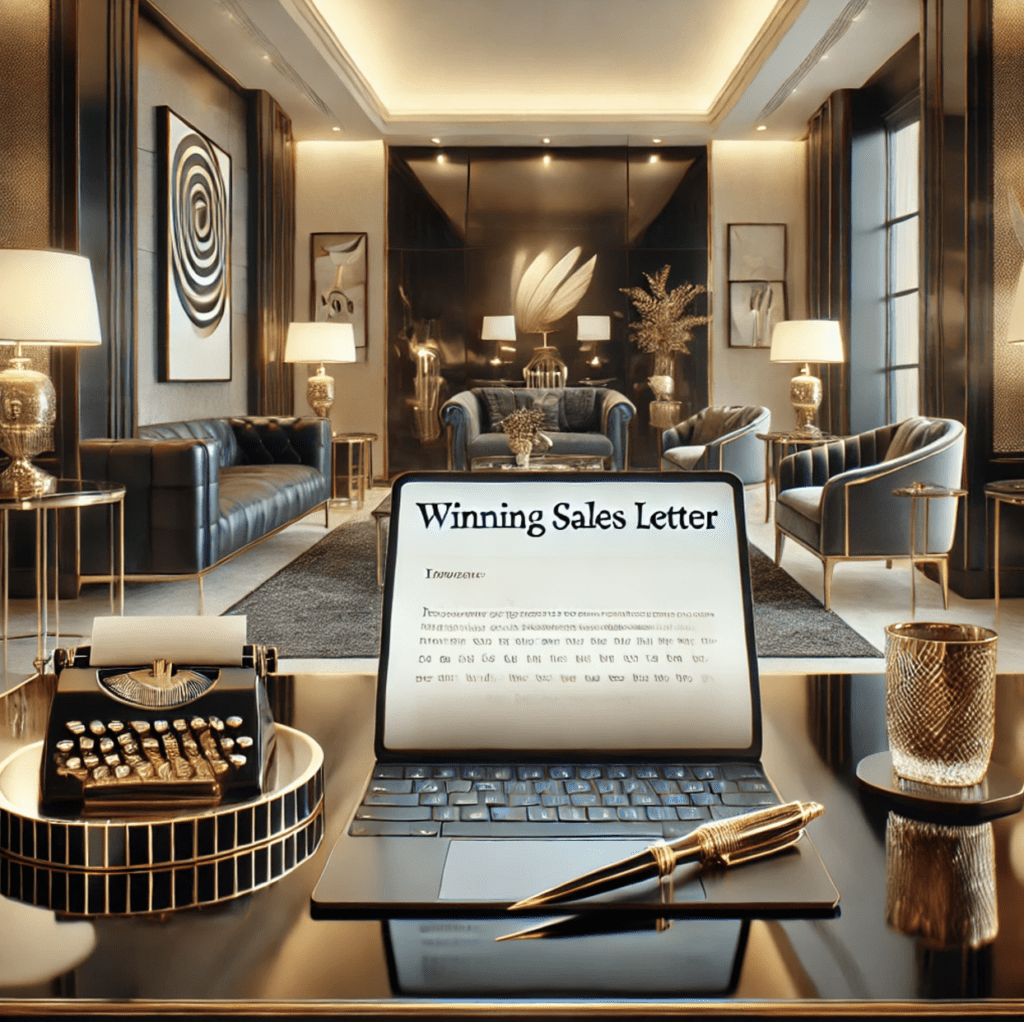Crafting an effective sales letter is an art form that combines:
- Psychology
- Marketing acumen
- And a deep understanding of your audience.
The best sales letters are more than just persuasive texts – they are well-structured narratives that guide potential customers through a journey from curiosity to conviction.
Here’s a detailed breakdown of the structure that top-performing sales letters often follow.
1. Headline: The Hook That Grabs Attention
The success of a sales letter often hinges on its headline.
This needs to be more than just eye-catching – it should encapsulate a big idea or hook that directly addresses a core desire or pain point of the audience.
A great headline makes a bold promise or poses a provocative question that can’t be ignored, compelling the reader to continue.
2. Curiosity-Driven Lead
Following the headline, the lead should stoke the reader’s curiosity.
This can take the form of:
- A gripping nightmare story
- A contrarian viewpoint that challenges common beliefs
- Or an intriguing scenario that is unexpected.
The goal here is to create a narrative that resonates emotionally, setting the stage for a deeper exploration of the problem and its solution.
3. Credibility and Background
Before diving deeper, it’s crucial to establish the credibility of the spokesperson or the brand.
This section should highlight:
- Relevant qualifications
- Experiences
- Or a unique backstory
that positions the spokesperson as a relatable and trustworthy figure.
It helps to bridge the gap between the audience and the speaker, fostering a connection based on shared experiences or expertise.
4. Discovery Story
The discovery story is where the spokesperson shares the journey of how they discovered or developed the solution being offered.
This narrative should be engaging and filled with genuine discovery moments that led to the breakthrough, making the solution not only believable but seemingly inevitable.
5. Highlighting Flawed Common Solutions
To set the stage for presenting the product, it’s effective to first discuss common solutions that fail to address the problem adequately.
This not only shows the audience that the spokesperson understands the market but also sets up the introduced solution as a superior alternative.
6. The Big Idea and Its Unique Mechanism
Now, introduce the big idea or the unique mechanism of the product, explaining why it’s the only viable solution for the audience.
This should be a clear and compelling explanation of how the product works differently from anything else on the market, ideally tied back to the unique insights shared in the discovery story.
7. Ingredients or Modules
Detail the components or modules of the product.
Each part should be described in a way that reinforces its value and shows how it contributes to the overall effectiveness of the product.
This section is about transparency and building understanding and anticipation.
8. Introduction of the Product/Service
With the groundwork laid, formally introduce the product or service.
Highlight its:
- Features
- Benefits
- And outcome
focusing on how it meets the needs + solves the problems identified earlier in the letter.
This should be a natural progression from the earlier sections, showing the product as the embodiment of the solution.
9. Comparison with Other Products
Offer a comparison with competing products or services, highlighting how and why this product is superior.
Focus on aspects like:
- Effectiveness
- Ease of use
- Pricing
- And additional benefits that competitors do not offer.
10. Testimonials and Social Proof
Incorporate:
- Testimonials
- Mentions in media
- And other forms of social proof.
Real stories from real users provide credibility and help to alleviate any skepticism the reader might have.
This section reinforces the value proposition with evidence of success.
11. AOV (Average Order Value)
Discuss the average order value with things that might include:
- Time-limited offers
- Discounts
- Or exclusive bundles.
This creates urgency and incentivizes immediate action.
12. Bonus Section
If applicable, detail any bonuses that accompany the main offer.
Bonuses should add more value than the offer itself, enhancing the main product and making the purchase irresistible.
13. Guarantee
Offer a guarantee or similar assurance to mitigate risk.
This shows confidence in the product’s quality and aligns with customer satisfaction.
14. Crossroads Close
The crossroads close involves presenting the reader with a choice:
Continue with their current situation or take a leap towards a better scenario through the offered product.
Be sure to emphasize how the cost of inaction is even more expensive.
This helps to frame the purchase as a pivotal decision.
15. FAQ
Finally, address common questions or concerns with an FAQ section.
This not only clears up uncertainties but also reduces friction in the decision-making process.
Conclusion
By following these steps, a sales letter can effectively guide a potential customer from initial intrigue to the final decision, leveraging every element of the structure to build a compelling, persuasive case for the product.
You May Also Like:
The Value Of Bootstrapping Your Biz
REVEALED: The #1 Bottleneck To Your Business Growth (And How To Fix It)
I Will Show You How To Start Building A Brand - As Professionals Do
Kardashian Branding Lessons - A Tale of 2 Sisters
5 Questions To Ask Before Starting Your Business
Exclusive Multi-Millionaire Success Stories: Cybersecurity Entrepreneur
What's The Strongest Force In Psychology (And How Does It Affect You)?
The Hidden Power of Friction: How to Use It to Skyrocket Your Income, Filter Out Toxic People, and Q...
My name is Mister Infinite. I've written 600+ articles for people who want more out of life. Within this website you will find the motivation and action steps to live a better lifestyle.


